Formula 1 News: 2025 São Paulo GP at Interlagos Preview
Round 21 of the 2025 FIA F1 series takes the ten F1 teams to Brazil, for the São Paulo Grand Prix, at the Autodromo Jose Carlos Pace, also called Interlagos.
Interlagos is a proper driver’s circuit with plenty of undulation and a challenge mix of low, medium, and high-speed corners.
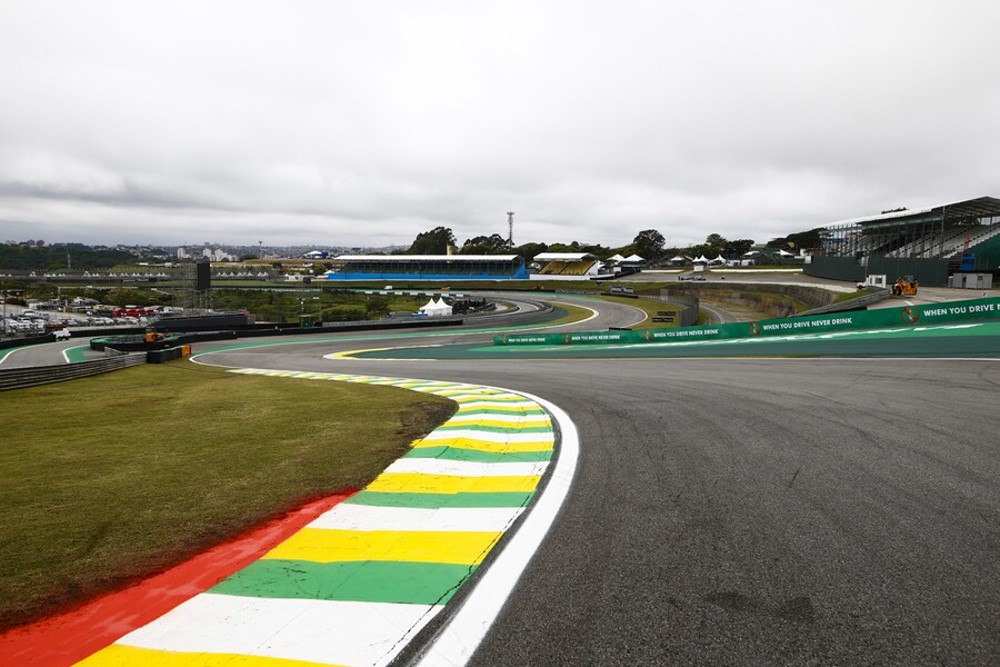

Brazil first joined Formula 1’s calendar in 1972, with the circuit taking its official name from Carlos Pace, the late local icon who recorded his sole victory there in 1975. The venue is usually referred to as Interlagos, after the district located between the man-made reservoirs of Guarapiranga and Billinges, and directly translating as ‘between lakes.’
It first opened in 1940 and, after an absence in the 1980s when Brazil’s grand prix relocated to Rio de Janeiro, returned to the Formula 1 schedule for good in 1990, absent only once in 2020 due to the pandemic. The bumpy, undulating circuit features a sequence of long-radius medium- and high-speed corners, juxtaposed with a lengthy full throttle section that takes drivers from Juncao to the Senna S complex, the best overtaking spot on the circuit, which is named after Brazil’s sporting hero Ayrton Senna.
Interlagos will again host F1 Sprint – the fifth appearance of six for the format in 2025. Interlagos is the only circuit at which F1 Sprint has been run every year since the concept was introduced into Formula 1 in 2021.
The circuit is among Formula 1’s shortest, with 2.67 miles of tarmac condensed into Interlagos’ small campus, and features two lengthy full-throttle sections connected by long-radius undulating turns.
The record race winner on Brazilian soil is Alain Prost with six victories to his name, ahead of Michael Schumacher on four. Lewis Hamilton shares third place in this category with Carlos Reutemann and Sebastian Vettel, each having won on three occasions. Michael Schumacher has the most podium finishes (10), ahead of Fernando Alonso (8). Hamilton once again shares third place, this time with Prost and Kimi Räikkönen, each of them having made seven podium appearances. In the all-time qualifying rankings, the legendary Ayrton Senna is the undisputed leader with six pole positions.
2024 Race: Verstappen 17th-to-1st in brilliant wet São Paulo GP drive
Max Verstappen showed the world why he may be the greatest driver of all-time by putting on a masterclass drive in heavy rain from 17th to win the São Paulo Brazil GP on the Interlagos Circuit.
–by Mark Cipolloni–
Once he got in the lead by passing the Alpine of Esteban Ocon, Verstappen set the fastest race lap after fastest lap and won going away by 19.477-seconds over Ocon. In the wet Verstappen was lapping a second faster than all the other drivers in the field and also took the extra point for fastest lap by setting 17 fastest laps in the race.

Last year, qualifying and the race both took place on Sunday. With bad weather forecast, the Race Director decided to run qualifying at 07.30, as well as bringing the Grand Prix start time forward to 12.30. Dry weather tires were never used at any time during the day.
All drivers were on Intermediate tires for the start, and at half-distance the race was red-flagged as the rain intensified. At that point, just five drivers had fitted Full Wets. After the restart, all drivers completed the race on intermediates, only four of them running a new set.
Verstappen was driving the inferior Red Bull, but they say the rain separates the greatest driver from the wankers, and Verstappen made a statement today the F1 paddock won’t soon forget.
“My emotions today have been a rollercoaster with qualifying being unlucky with the red flag. But we stayed out of trouble, made the right calls, and we were flying, Unbelievable, to win here from so far back on the grid,” said a happy Verstappen.
Verstappen’s drive reminded me of Senna at Donington 1993, some called walking on water.
A generational drive for a generational driver. Verstappen can clinch the world championship in Las Vegas next time out if he leaves that weekend with a lead of 60+ Points.
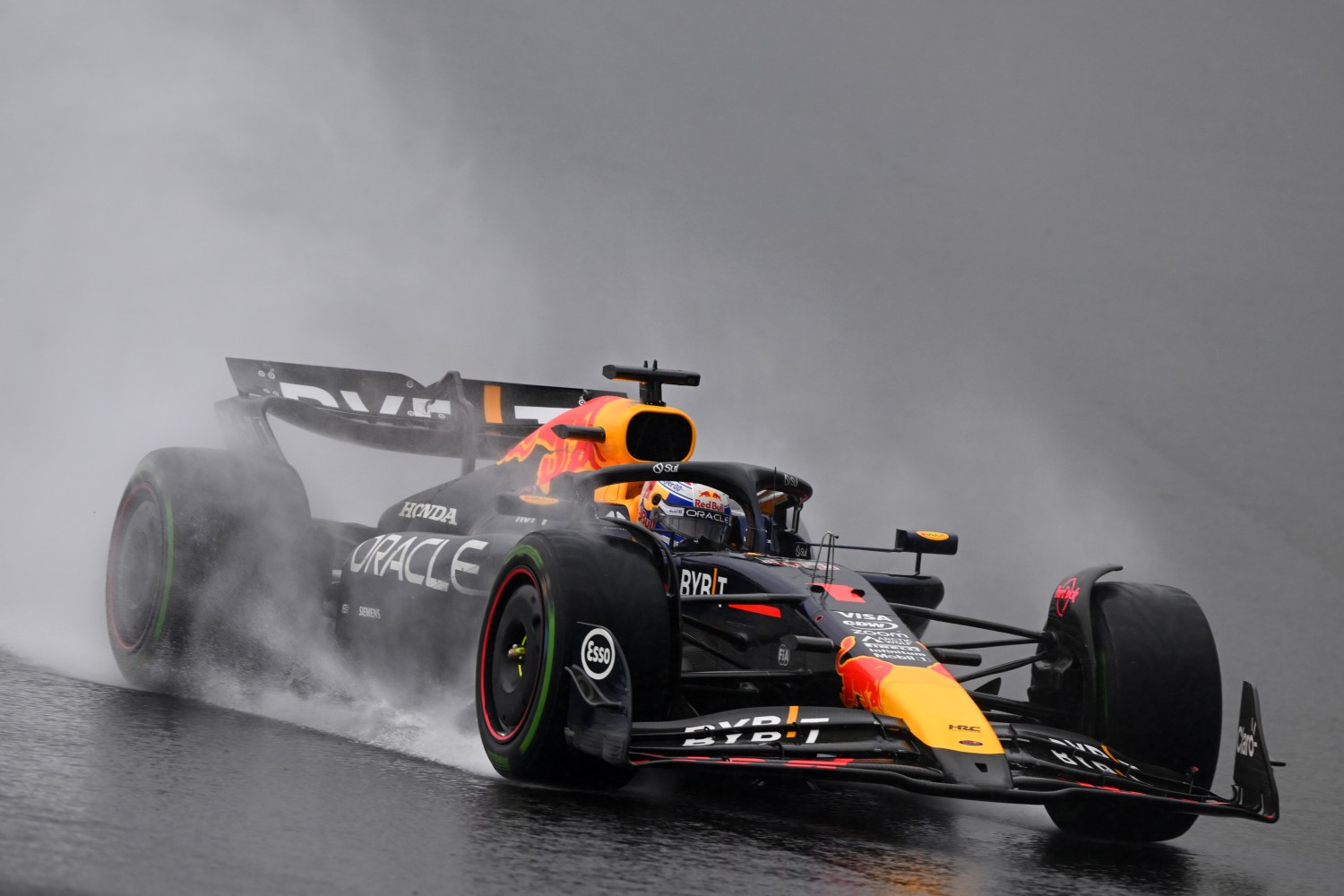
Pierre Gasly was third, 22.5s behind Verstappen, giving the Alpine team a 2nd and 3rd on the podium.
2025 Race Forecast – Wet Saturday?

Fact File: São Paulo Grand Prix
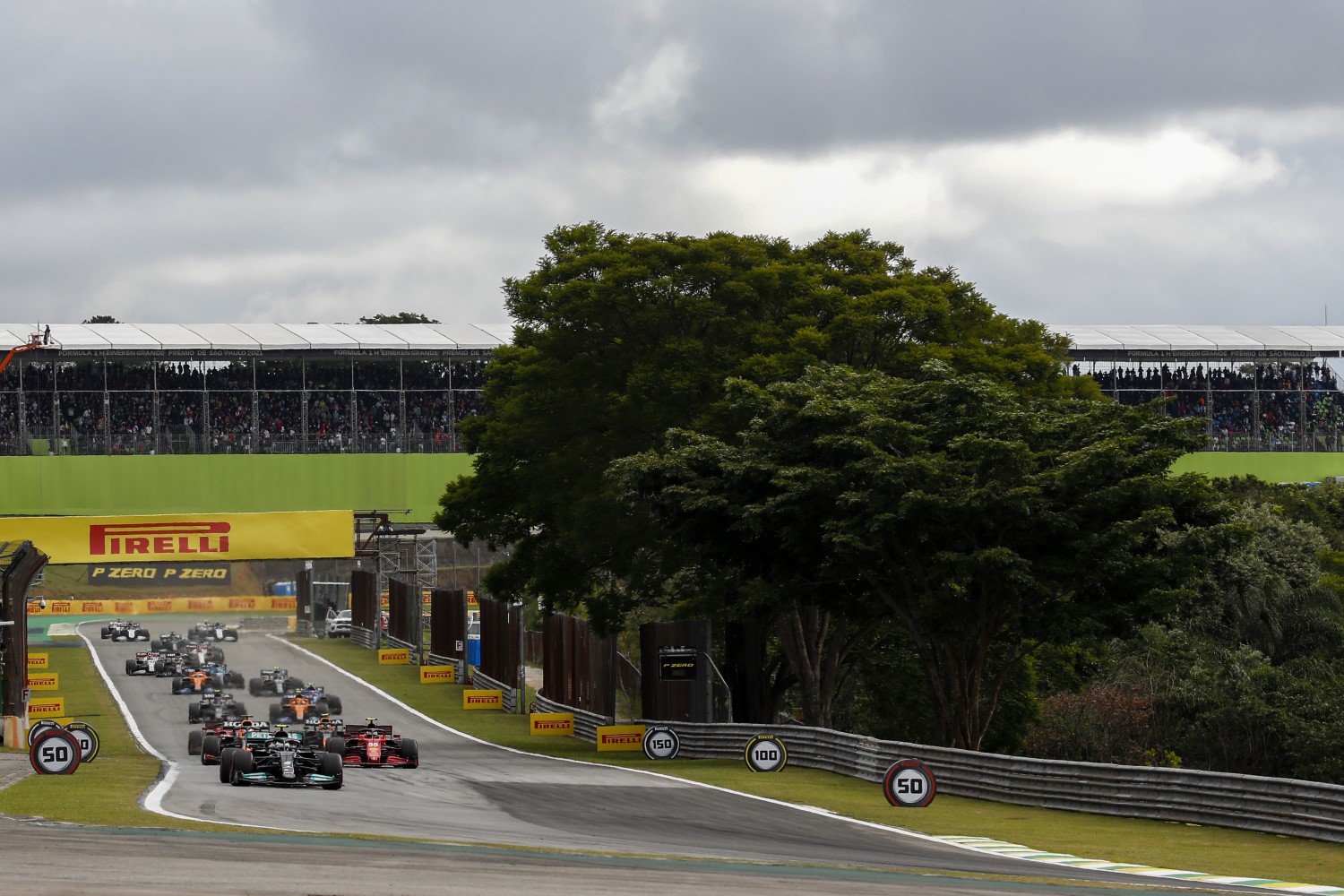

- The São Paulo Grand Prix venue is situated 800 meters above sea level, the second-highest altitude on the F1 calendar behind Mexico City (which sits at 2,300m above sea level).
- Interlagos is a track of two extremes. The first and third sectors require a low-drag car for the long straights, but the middle sector is twisty, requiring high downforce. The second DRS zone means more focus is typically on higher downforce for the ultimate fastest lap, but a balance still needs to be found with being competitive on the straights during the race.
- There is 1.2 kilometers of driving at full throttle between the exit of Turn 12 and the braking zone for Turn One, with an elevation change of 33 meters.
- The biggest difference in elevation is from the start/finish straight to Turn 4 where there is a 40-meter drop in elevation.
- The long straight before the lap begins also requires some clever deployment of energy from the ERS to maximize performance towards the end of the out lap, as the drivers start their flying lap.
- Turn 1 is banked heavily towards the inside, unloading the front-left wheel and causing frequent lockups. However, because the tire is unloaded, flat spots are less likely and time loss isn’t as high as you’d expect, due to the steep banking and variety of corner lines drivers can take. The variety of lines is also what makes this corner well suited to overtaking.
- The uphill grid requires the drivers to find the balance between holding the car on the brakes as gently as possible, without rolling backwards.
- From Turn 10 to Turn 6 (around 3.5 km of distance) the left-hand front tire does very little work and therefore cools down quickly, providing a tricky engineering challenge to keep the tire in its temperature window.
- With long straights and a second DRS zone, Interlagos is one of the best tracks of the season for overtaking. However, it can be difficult for the defending car to manage its battery, as there aren’t many big braking zones to recover energy.
- The São Paulo Grand Prix is the fifth F1 Sprint of the 2024 season, with just Qatar left on the Sprint calendar this season.
- This will be the fourth consecutive year that the circuit has hosted a Sprint weekend.
- Interlagos is a very flowing circuit with a lot of combined corner entries (where you are cornering and braking at the same time), meaning good stability is important. However, you also need a good front end for the low-speed middle sector.
- Track temperatures can reach some of the hottest of the season in Brazil, up to 60°C. And thunderstorms are common around this time of year, which can potentially spice up the weekend.
- Since 2021, the race around the circuit has been known as the São Paulo Grand Prix.
Unlocking the Lap

A lap begins immediately with the tricky ‘S’ do Senna, named after the Brazilian icon. This is a tricky downhill left-right chicane that merges into the long Curva do Sol.
Heavy braking takes place incredibly late – after the 50-meter board, with drivers decelerating and turning into the cambered, blind-apexed corner, making it easy to lock up. The second part is easy to get wrong by taking too much curb.
Turn 10 – Bico de Pato – is a tricky little hairpin at the end of a sequence of punishing long bends. This is another corner where it is easy to lock a wheel and run wide and this compromises the exit massively.
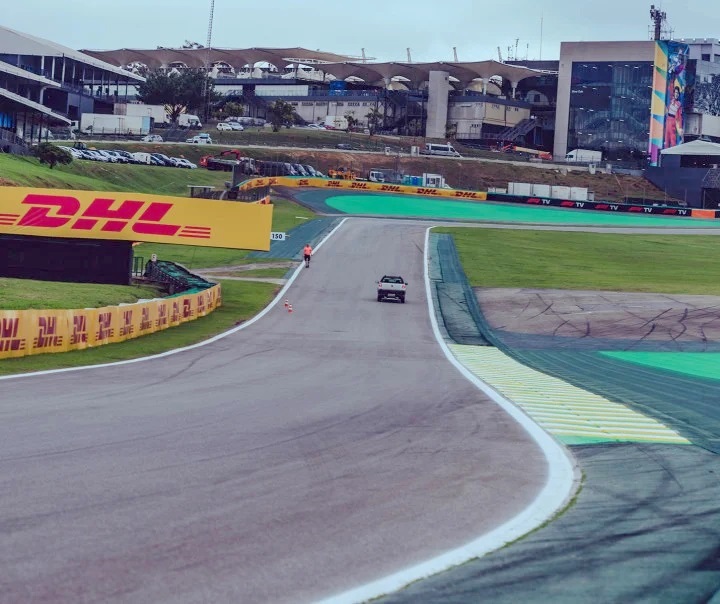
The last notable corner – Juncao, Turn 12, has been the scene where races and even a World Championship have been decided. The approach is downhill before a climb up to the corner itself. Deceptively tight, this turn needs to be mastered because of the long, uphill blast to the finish line that follows.

Things to look out for
Overtaking: Expect plenty of moves to be made throughout the race and in the Sprint. Oval-like circuit characteristics, high tire wear and tricky braking zones into Turns One and Four all promote overtaking. In fact, over 80 percent of moves are done into T1 or T4 – the end-points of the two long DRS zones.
Safety Cars: The Safety Car often gets used at Interlagos. The very wet 2016 race featured no fewer than six SC periods. With a low pit-lane time-loss, it is often beneficial to stop during an interruption. VSCs are much less frequent, with the two appearances both coming in 2021. Last year’s wet race saw the Safety Car deployed several times.
Strategy: This is regularly a two-stop race due to the ease of overtaking and tire wear, with Pirelli bringing the C2, C3 and C4 compounds, one step harder than last year, so a 1-stop strategy may work in 2025. The weather can change at Interlagos in an instant and can cause mayhem during a race weekend, keeping every strategist and mechanic on their toes.
TV Schedule
All Times Eastern
| Friday, November 7, 2025 | Location | TV Times | Network |
| Formula 1 São Paulo GP Practice 1 | Interlagos | 9:25am – 10:30am (Live) | ESPN2 |
| Formula 1 São Paulo GP Sprint Qualifying | Interlagos | 1:25pm – 2:30pm (Live) | ESPN2 |
| Saturday, November 8, 2025 | Location | TV Times | Network |
| Formula 1 São Paulo GP Sprint Race | Interlagos | 8:55am – 10:00am (Live) | ESPN2 |
| Formula 1 São Paulo GP Qualifying | Interlagos | 12:55pm – 2:00pm (Live) | ESPNews |
| Sunday, November 9, 2025 | Location | TV Times | Network |
| Formula 1 São Paulo GP Pre-Race | Interlagos | 10:30am – 11:55am (Live) | ESPN2 |
| Formula 1 São Paulo GP | Interlagos | 11:55am – 2:00pm (Live) | ESPN2 |
| Formula 1 São Paulo GP Post-Race | Interlagos | 2:00pm – 3:00pm (Live Stream) | ESPN3 |
| Formula 1 São Paulo GP | Interlagos | 8:00pm – 10:30pm (Replay) | ESPN2 |
| Formula 1 São Paulo GP | Interlagos | 12:00am – 2:00am (Replay) | ESPNews |
Pirelli Tires
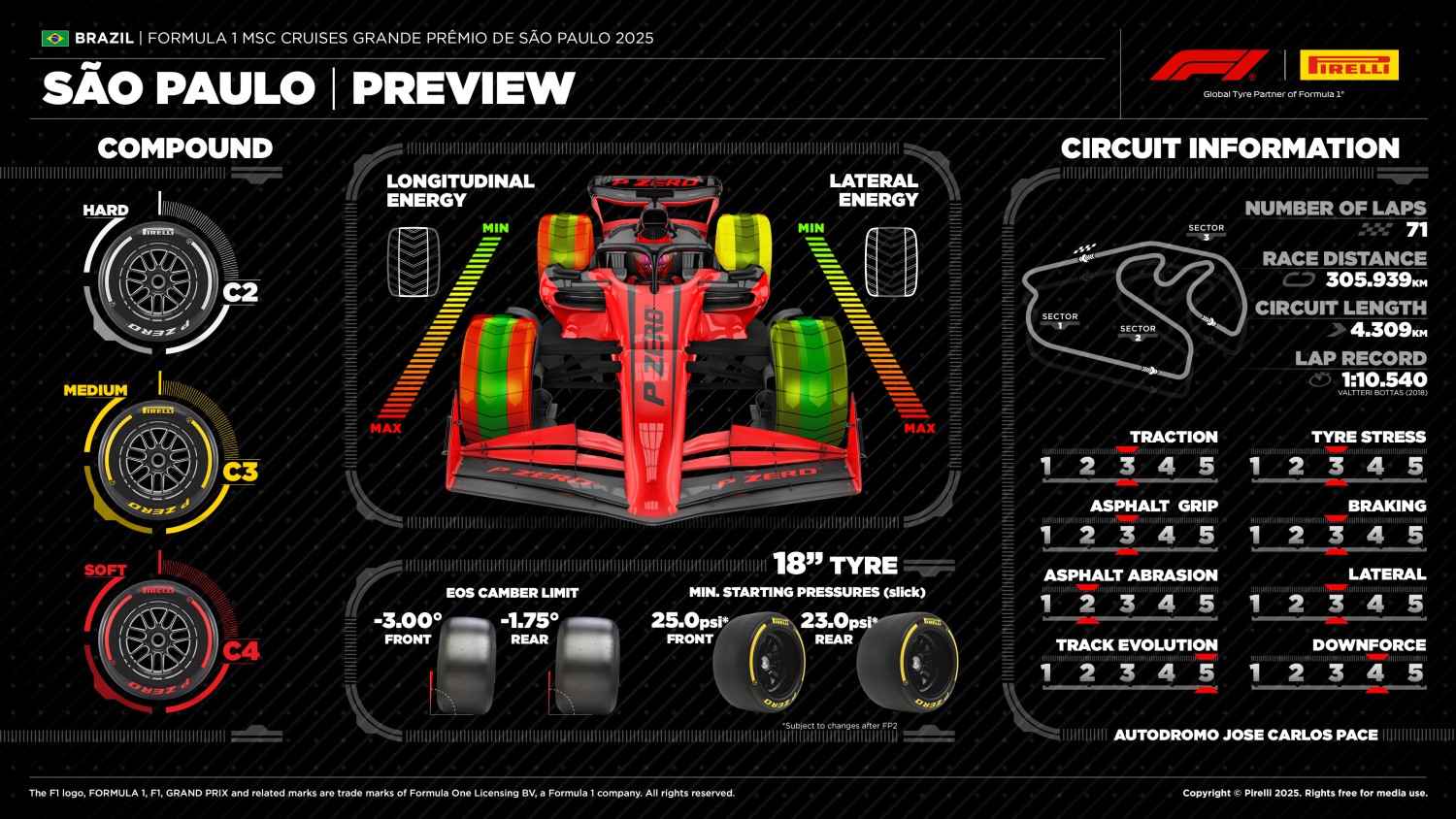
This year’s compound selection for the São Paulo Grand Prix harks back to 2023, with the C2, C3 and C4 as Hard, Medium and Soft, therefore one step harder than the trio used last year.
Last year, the dry weather tires were not required for the race, but when used on Friday and Saturday morning, they showed high levels of wear, as well as graining, especially on the rear axle. The circuit had been completed resurfaced, thus leaving a very smooth surface, less abrasive than in previous years, although still with plenty of bumps around the track.
If conditions are similar, with the inevitable variations due to the aging of the asphalt, the decision to bring harder compounds could thus extend the performance life of the tires, which are already more resistant to degradation than the 2024 range. That might allow the Soft to come into play, which last year was only used for Sprint qualifying.
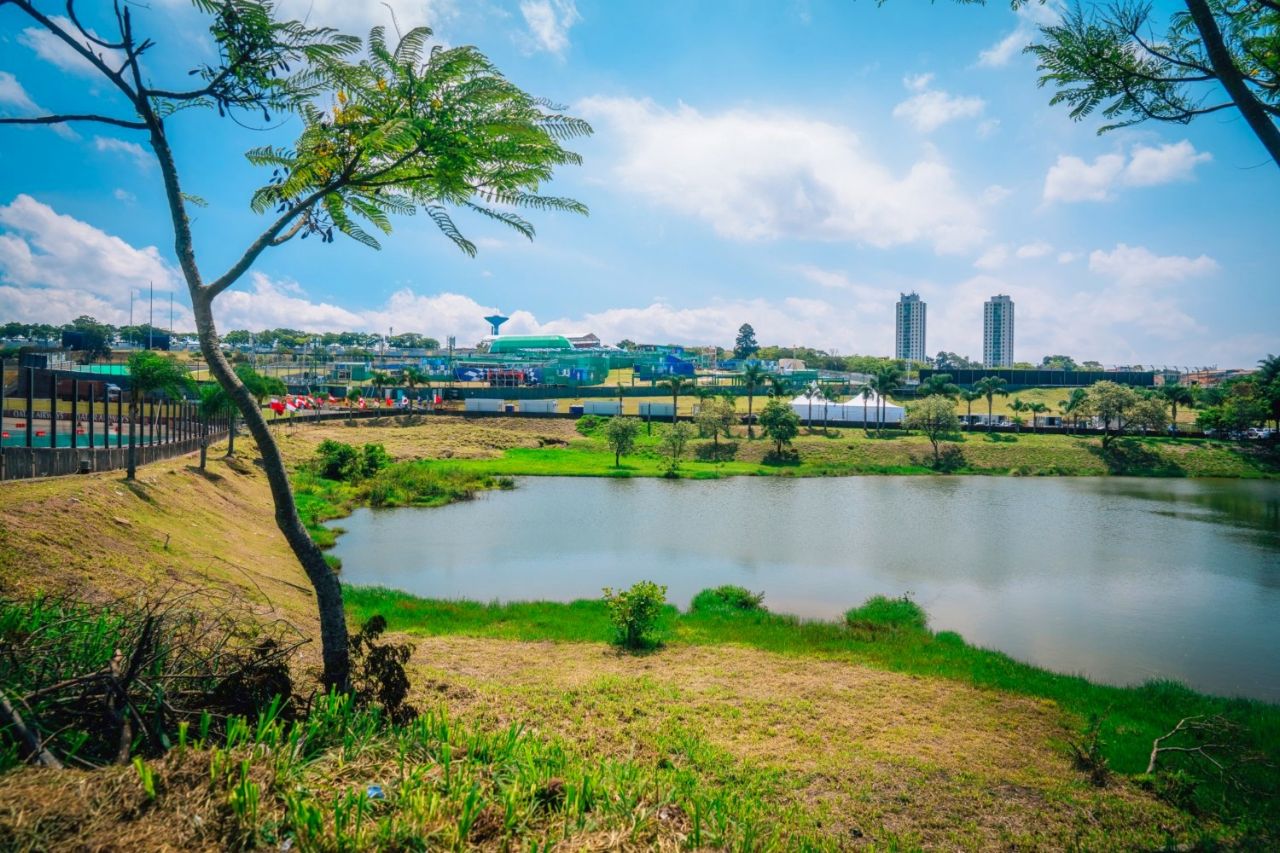
At Interlagos, the lateral and longitudinal forces exerted on the tires around the 15 corners of this anticlockwise track are medium to low in intensity and well distributed across both axles. Furthermore, the new track surface could see a lowering of lap times and, as a consequence, an increase of the stress to which the tires are subjected.
